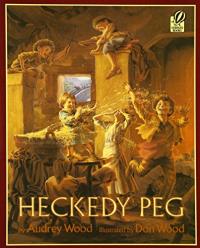
A mother warns her seven children not to open the door in her absence, but alas, the children are duped by a tricky witch named Heckedy Peg. Their mother’s wisdom, however, cleverly saves the day. Told in the cadence of a folktale, this richly illustrated tale makes a fine read aloud.
Heckedy Peg
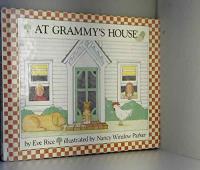
A sister and brother walk over the hill to spend Sunday afternoon with their French-speaking grandmother. Licking spoons, milking the cow, shaking cream into butter, and setting the table are all part of the fun. Meanwhile Grammy, seemingly without effort, produces a wonderful feast for all. When their parents come to pick them up, the children look forward to the following Sunday gathering.
At Grammy’s House

Benny Bakes a Cake

Crisp color photographs of fruits and vegetables are presented. One of each is presented on the left of the double page spreads, while variations of the fruit or veggie (e.g., there are 12 different citrus fruits) are introduced on the opposing page. There is potential to introduce new edibles — perhaps at your local farmer’s market — while counting and playing with numbers.
Edible Numbers

An entire community comes together to create and learn from a garden. Students with their teachers plant a variety of edible plants from tomatoes to radishes. They explore insect residents of the garden and more. Finally, everyone comes together to enjoy the harvest. Photographs and a conversational text document this pleasure of a garden project.
It’s Our Garden: From Seeds to Harvest in a School Garden

From fish to produce, the detailed maps and a list of things to find on each double page spread, demystify how the produce sold at a farmers market gets there. Sophisticated children will be able to follow the maps; younger children will look for specific objects in this attractive book that requires keen sight and much examination.
Market Maze
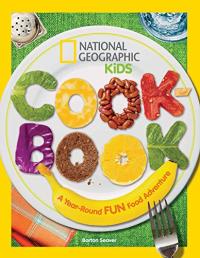
Foodies and cooking aficionados as well as those only marginally interested in food are sure to find something to enjoy in this handsomely formatted and enriching look at food. Recipes range from easy to more complex and are placed amid information and activities for the entire year.
National Geographic Cookbook: A Year-Round Fun Food Adventure

What better way for three cubs to spend an afternoon than baking with Grandma. Together they bake and wrap chocolate cake before walking home through the snowy woods, all told in warm illustrations and cozy rhyming text. A recipe for Grandma Rosie’s chocolate cake is included.
Baking Day at Grandma’s

Beginning readers will appreciate the easy language and color photographs that describe necessary preparations and what zookeepers then feed animals. Children are shown at a petting zoo and eating a snack themselves in the book’s final images.
Feeding Time at the Zoo
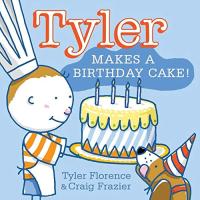
When Tyler forgets his dog’s birthday, he goes to Mr. Baker to learn how to bake a cake. There the boy learns about where the ingredients for a carrot cake originate. Childlike illustrations provide information and humorous asides from Tofu, the dog. Tyler’s DOG carrot cake recipe is included.
Tyler Makes a Birthday Cake

Sophie lives in a big city but eagerly anticipates summer at her grandparents. There, she learns about growing vegetables and gardens as she prepares, plants, observes and harvests. Realistic illustrations show an entire scene as well as close-ups on each double page spread.
How Does My Garden Grow?
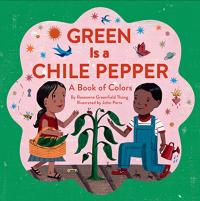
Colors introduce foods and more Mexico and other Spanish-speaking counties. Naïve style illustrations accompany bouncy rhymes that incorporate Spanish words; all colors appear in both Spanish and English.
Green Is a Chile Pepper

“I am a plant eater,” announces a boy with a wide grin eating munching on a slice of watermelon and surrounded by a harvest of fruits and vegetables. He then introduces where, how, and the different parts of what he (and we) eat. Cheery, informative illustrations are clearly labeled and correspond to the straightforward, engaging text.
Plants Feed Me

The mayor of Food Town introduces each of the five groups: grains, vegetables, fruit, protein, and dairy. Each personified group parades through town with its relatives. Humorous illustrations of foods with personality, all labeled, are used with an understated text to present palatable nutrition information. A bit more easily digestible information ends the book.
The Food Parade: Healthy Eating with Nutritious Food Groups

Tasty recipes made by a young orphan named Cady with a special Talent are at the center of the mystery that involves old suitcases and an old peanut recipe — with just a touch of magic. The well-paced plot with its memorable characters unfolds through crisp narration. (Tasty recipes included!)
A Tangle of Knots

Most kids like something chocolate-y, right? But there wouldn’t be chocolate without cocoa beans that come from cocoa pods that rely on insects and other creatures in rainforests — even monkeys! A brief but engaging look at this interconnected habitat is realistically illustrated with informative but humorous asides by bookworms to encourage each page turn.
No Monkeys, No Chocolate

Poor Maggie struggles to master her chopsticks — it seems nearly everyone around the dinner table has something to say about the “right” way to hold them! But when Father reminds her not to worry about everyone else, Maggie finally gets a grip on an important lesson.
Maggie’s Chopsticks

The ingredients needed to make cookies launch a journey around the world to find out who contributed what from different parts of the world. Rhyming couplets and cheery illustrations reminiscent of folk art combine to answer the question posed as a title.
Who Put the Cookies in the Cookie Jar?

Willy’s barbeque is about the best around, even attracting green, 3-eyed, barbeque-loving aliens! Laughs abound in the rhyming tale and swirling, understated illustrations and its surprise ending.
Take Me to Your BBQ

The children are distressed that it’s raining while visiting their grandfather. But Grandpa has the children don rain gear to “find colors for garden stew.” Vegetables collected, the family makes and eats a delicious stew. Joy-filled illustrations accompany the rhythmic text.
Rainbow Stew
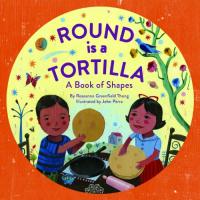
Circles, squares, triangles, ovals and stars are all around! The rhyming text incorporates Spanish words which are defined in illustrations reminiscent of folk art. A glossary of Spanish words concludes this engaging glimpse into Mexican culture.
Round Is a Tortilla: A Book of Shapes

“Lily-Rose May was a sweet little girlie…” who discovered she really was a princess because of her reaction to peas. When she joins royalty, however, Lily-Rose figures out what’s really important. Told in spritely verse and humorous illustration, Lily’s adventure comes alive.
The Princess and the Peas

Everyone eats so naturally, the kitchen is the place to discover more about it. Chemistry is with us every day and in many ways, introduced in an informative, conversational text and easy-to-do activities with readily available materials.
Science Experiments You Can Eat

Easy activities and commonplace snack foods bring basic principles of chemistry into focus. Combined with snappy full-color photographs, the information is clearly presented and sure to inspire as it informs.
